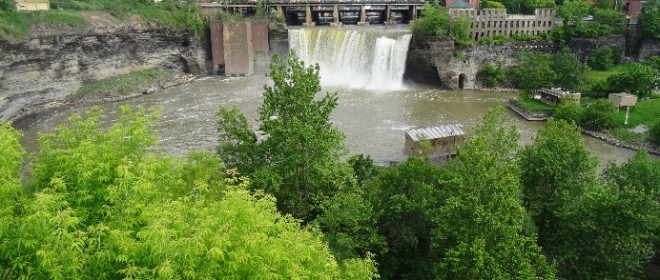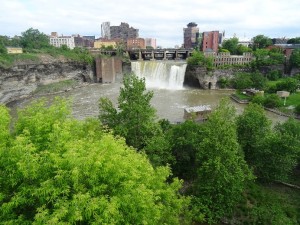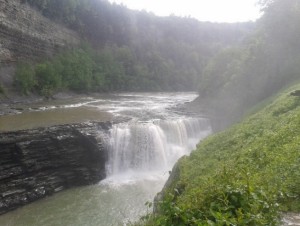
Rebecca McGuire-Snieckus
‘The Genesee Would Rebel’: the story of our attempts to tame a river and how it was saved.
Posted on November 10, 2016

Dr Trevor Turpin
‘The Genesee would rebel’ was the prediction of Lyman P. Langworthy, the Rochester City Health Officer, in a note he placed in the cornerstone of the new Monroe County Court house in 1850.[1] Rochester lies at the mouth of the Genesee River as it enters Lake Ontario and had suffered serious floods since the 1780s. Finally, or so the citizens of the city thought, their improvements to the river banks with a narrow channel confined by mills and retaining walls, had brought the river under control.
The Genesee flows for more than 150 miles north from its source in Potter County, Pennsylvania right across New York State to Rochester, its catchment being over 2,500 sq. miles. It drops over 2000 feet in its travels, forming two sets of dramatic waterfalls: three in Letchworth State Park and three in Rochester where it cuts through the same dolomitic limestone rock formation as Niagara to the west.
Genesee High Falls, Rochester
The Native Americans, the Seneca, who lived along the length of the Genesee, called it Jenishiyah, meaning River of the Shining Valley and the river was their lifeline: trails were important for both hunting and trading and the valley provided a route into the hinterland from Lake Ontario.
The power of the river was first recognised in the early 19th century when a grist mill was built in Rochester; by 1815, the Brown brothers had built a channel from the High Falls to carry ‘racing water’ from the Falls to provide a source of power for a number of mills such that, by the 1830s, Rochester was known as ‘Flour City’. When flour production moved to the mid-west later in the century other industries moved in – eventually including George Eastman and his Kodak empire – all drawn by the power of the Genesee.
Needless to say this enterprise, clustered on the river as it had to be, constrained the Genesee at times of high flows and flooding became a way of life. As has been seen there were a series of flood events through the early 19th century culminating in what the city thought had finally brought the river under control in the 1850s. However Langworthy’s premonition was sustained on St Patrick’s Day 17th March, 1865 when telegraphs were received in Rochester warning of high river flows in the upper Genesee – once again the Genesee burst its man-made banks. It was the worst flood in Rochester’s history.
In the early years of the 20th century, two river deepening and dredging projects in Rochester increased the river’s capacity to carry flood water through the city: as if in protest, the river once again broke free in 1916. As Ruth Rosenberg-Napersteck says[2] ‘the youthful Genesee demonstrated its strength and that man was not yet in control’. Meanwhile, the Genesee River Company proposed a dam upstream of the Letchworth Falls at Portageville to, among other objectives, check flooding, improve water supply and, incidentally, utilise the water power created by the construction of the dam. The American Scenic and Historic Preservation Society petitioned the legislature to oppose this proposal. In 1859 William Pryor Letchworth, a Buffalo industrialist, had purchased a deforested area of the Genesee valley and transformed it into a park. In 1907 he offered it to the State as a public park on condition that no dam was built at Portageville. Clearly the River Company’s plans would have been contrary to his wishes.
Letchworth Lower Falls
Nevertheless, there was clearly a need for ‘something to be done’ and in August 1928, the Mount Morris Enterprise announced that a ‘dam would be started next fall’[3] at Mount Morris. This would be towards the downstream end of the Park leading to the flooding of the Park. It was claimed that it would provide a means of flood control and generate 90K HP of power. It failed to materialise, principally on the grounds that it would be counter to Letchworth’s stipulation and general opposition from admirers of ‘his’ park. After another flood in 1942, a group of citizens of Rochester campaigned for a permanent solution. Including ‘housewives, a baker and a farmer’, they were later credited by the Rochester Times Union[4] with the promotion and approval of the Mount Morris flood control dam. It was approved by Congress in 1944 but due to resources being focused on the war, it was not started immediately.
Construction of the dam was finally started in March 1948 and completed in May 1952: it is a concrete gravity dam[5] and was designed not to hold back water in normal flow conditions but rather to provide storage during high river flows and storm conditions in the catchment. So although there was a massive concrete structure across its valley, the Genesee could still follow its accustomed course as long as the gates of the dam were open. The Genesee was saved! Or was it?
The first indication that there may have been a hidden agenda had come in the hearing to consider the dam: the Rochester Gas & Electric Corporation had protested that the planned dam was clearly intended for hydropower since it was too high merely for flood control. Their fears were dismissed (and proved wrong in their assumption as will be seen). However, in January 1950 (whilst the dam was under construction), President Truman in his budget speech requested that $8m be set aside since development of hydropower at the site was ‘under consideration’. This was confirmed by Ray Sherman, the owner of the Livingston Republican, who remembered[6] on a visit to the dam during construction that an engineer showed him ‘facilities to convert to a power dam with not much effort’. He asked why since the purpose of flood dams and power dams were diametrically opposed to be told ‘that’s the way we build dams’: of course he wondered why the engineers would go to such additional unnecessary expense. However nothing came of this and the dam was completed as intended and as designed. It is the largest flood control dam east of the Mississippi.
Mount Morris Dam from Letchworth Park
It first proved its worth in 1956 when record water levels were measured at Mount Morris. But the real test came in June 1972 when Hurricane Agnes swept through the State. Although the river flow exceeded the storage capacity of the ‘reservoir’, controlled release of water prevented overtopping and minimised flood damage downstream. This was not the case in other cities in the US north east where billions of dollars’ worth of damage was caused by flooding. The Livingston County News proclaimed that the Dam ‘has been a real bargain at $25m’ having prevented damage estimated at $1bn.[7]
And still the rumours of it being converted to a hydro dam rumbled on – in 1977, the Rochester Democrat & Chronicle raised the question but the US Corps of Engineers (responsible for the dam) opposed it saying that although the site had potential, since it would interfere with the primary purpose of flood control, to harness the power of the Genesee would require another dam.[8] Then in 1987, it was again proposed to generate power at the site which would result in the flooding of the gorge. There was outcry, supported by the Corps of Engineers who were quoted as saying that rather than ‘enhancement of the gorge as claimed, it was better described as destruction since it would back up the river for 11 miles’.[9] Senators, Congressmen and Assemblymen all opposed the plans and in 1988 the Letchworth Preservation Alliance was formed of citizens, legislators, representatives and even the Rochester Gas & Electric Corporation with the aim of preventing the loss of the gorge and the submergence of the Genesee. In March of that year Senators passed a Bill to add the river to the New York Wild & Scenic & Recreational River System. The hydro plans were still in place however but finally, in November 1989, President Bush declared protection of the river ‘in order to protect for present and future generations the outstanding scenic, natural, recreational, scientific, cultural, and ecological values of the Genesee River’.[10]
At last the ‘river that would rebel’ was saved to follow its natural course and to delight generations of visitors with its beauty and power.
Bibliography
Beale, Irene A. Genesee Country Senecas. (Geneseo, New York: Chestnut Hill Press) 1992.
Ensminger, Scott A. A Waterfall Guide to Letchworth State Park. (New York: Latko Instant Press) 1991.
Rosenberg-Napersteck, R. The Sleeping Giant: the story of the Mount Morris dam. Rochester History Vol.LV111 Summer 1996, No.3.
Acknowledgements
This article was inspired by the author’s visit to SUNY as part of the Global Academy of Liberal Arts (GALA), Lost Waters theme. Thanks to Carol Long and all her colleagues at SUNY Geneseo University for their hospitality and support during my study period at the University, in particular archivist in the Milne Library, Liz Argentieri, for her patience and resourcefulness, and to Stephen Winslow of the US Corps of Engineers who was a wealth of information of the Mount Morris Dam. Access to the Livingston County Historian archives is acknowledged with thanks. With thanks to Santander Universities and Bath Spa University for the funding that facilitated the visit and to Ian Gadd and Tracey Hill of Bath Spa University for their encouragement.
The author
Following a career which encompassed the environmental care of rivers, Trevor Turpin studied for the MA Literature, Landscape and Environment at Bath Spa University. His final project was an exhibition entitled ‘Remembering London’s Forgotten Rivers through a study of literature’. Details can be found here: www.trevorturpin.co.uk
[1] Rosenberg-Napersteck, p.3.
[2] Rosenberg-Napersteck, P.15.
[3] Mount Morris Enterprise, 8th August 1928.
[4] Rochester Times Union, 28th June 1952.
[5] It is 1026ft long, 246ft high and 221ft broad at its base. It lies 15miles downstream of the Letchworth Lower Falls.
[6] Audio recording February 20th 1990, from Livingston County archives.
[7] Quoted in Livingston County News, April 25 2002.
[8] Rochester Democrat and Chronicle, 5th October 1977.
[9] Rochester Times Union, ‘Don’t Flood the Letchworth Gorge’, September 24th 1987.
[10] Genesee River Protection Act of 1989.





Responses